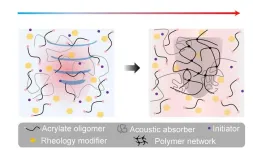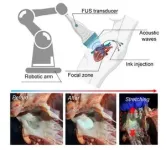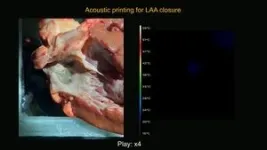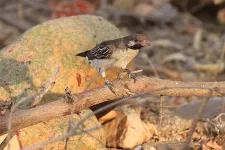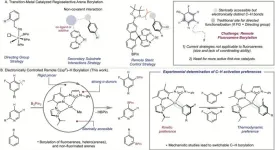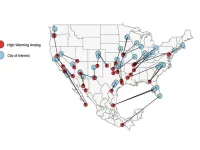(Press-News.org) DURHAM, N.C. -- Engineers at Duke University and Harvard Medical School have developed a bio-compatible ink that solidifies into different 3D shapes and structures by absorbing ultrasound waves. Because it responds to sound waves rather than light, the ink can be used in deep tissues for biomedical purposes ranging from bone healing to heart valve repair.
This work appears on December 7 in the journal Science.
The uses for 3D-printing tools are ever increasing. Printers create prototypes of medical devices, design flexible, lightweight electronics, and even engineer tissues used in wound healing. But many of these printing techniques involve building the object point-by-point in a slow and arduous process that often requires a robust printing platform.
To circumvent these issues over the past several years, researchers developed a photo-sensitive ink that responds directly to targeted beams of light and quickly hardens into a desired structure. While this printing technique can substantially improve the speed and quality of a print, researchers can only use transparent inks for the prints, and biomedical purposes are limited, as light can’t reach beyond a few millimeters deep into tissue.
Now, Y. Shrike Zhang, associate bioengineer at Brigham and Women’s Hospital and associate professor at Harvard Medical School, and Junjie Yao, associate professor of biomedical engineering at Duke, have developed a new printing method called deep-penetrating acoustic volumetric printing, or DVAP, that resolves these problems. This new technique involves a specialized ink that reacts to soundwaves rather than light, enabling them to create biomedically useful structures at unprecedented tissue depths.
“DVAP relies on the sonothermal effect, which occurs when soundwaves are absorbed and increase the temperature to harden our ink,” explained Yao, who designed the ultrasound printing technology for DVAP. “Ultrasound waves can penetrate more than 100 times deeper than light while still spatially confined, so we can reach tissues, bones and organs with high spatial precision that haven’t been reachable with light-based printing methods.”
The first component of DVAP involves a sonicated ink, called sono-ink, that is a combination of hydrogels, microparticles and molecules designed to specifically react to ultrasound waves. Once the sono-ink is delivered into the target area, a specialized ultrasound printing probe sends focused ultrasound waves into the ink, hardening portions of it into intricate structures. These structures can range from a hexagonal scaffold that mimics the hardness of bone to a bubble of hydrogel that can be placed on an organ.
“The ink itself is a viscous liquid, so it can be injected into a targeted area fairly easily, and as you move the ultrasound printing probe around, the materials in the ink will link together and harden,” said Zhang, who designed the sono-ink in his lab at the Brigham. “Once it’s done, you can remove any remaining ink that isn’t solidified via a syringe.”
The different components of the sono-ink enable the researchers to adjust the formula for a wide variety uses. For example, if they want to create a scaffold to help heal a broken bone or make up for bone loss, they can add bone mineral particles to the ink. This flexibility also allows them to engineer the hardened formula to be more durable or more degradable, depending on its use. They can even adjust the colors of their final print.
The team conducted three tests as a proof-of-concept of their new technique. The first involved using the ink to seal off a section in a goat’s heart. When a human has nonvalvular atrial fibrillation, the heart won’t beat correctly, causing blood to pool in the organ. Traditional treatment often requires open-chest surgery to seal off the left atrial appendage to reduce the risk of blood clots and heart attack.
Instead, the team used a catheter to deliver their sono-ink to the left atrial appendage in a goat heart that was placed in a printing chamber. The ultrasound probe then delivered focused ultrasound waves through 12 mm of tissue, hardening the ink without damaging any of the surrounding organ. Once the process was complete, the ink was safely bonded to the heart tissue and was flexible enough to withstand movements that mimicked the heart beating.
Next, the team tested the potential for DVAP’s use for tissue reconstruction and regeneration. After creating a bone defect model using a chicken leg, the team injected the sono-ink and hardened it through 10 mm of sample skin and muscle tissue layers. The resulting material bonded seamlessly to the bone and didn’t negatively impact any of the surrounding tissues.
Finally, Yao and Zhang showed that DVAP could also be used for therapeutic drug delivery. In their example, they added a common chemotherapy drug to their ink, which they delivered to sample liver tissue. Using their probe, they hardened the sono-ink into hydrogels that slowly release the chemotherapy and diffuse into the liver tissue.
“We’re still far from bringing this tool into the clinic, but these tests reaffirmed the potential of this technology,” said Zhang. “We’re very excited to see where it can go from here.”
“Because we can print through tissue, it allows for a lot of potential applications in surgery and therapy that traditionally involve very invasive and disruptive methods,” said Yao. “This work opens up an exciting new avenue in the 3D printing world, and we’re excited to explore the potential of this tool together.”
END
Soundwaves harden 3D-printed treatments in deep tissues
A specialized ink hardens when exposed to focused ultrasound waves, transforming into biologically compatible structures
2023-12-07
ELSE PRESS RELEASES FROM THIS DATE:
Physicists ‘entangle’ individual molecules for the first time, hastening possibilities for quantum information processing
2023-12-07
For the first time, a team of Princeton physicists have been able to link together individual molecules into special states that are quantum mechanically “entangled.” In these bizarre states, the molecules remain correlated with each other—and can interact simultaneously—even if they are miles apart, or indeed, even if they occupy opposite ends of the universe. This research was recently published in the journal Science.
“This is a breakthrough in the world of molecules because of the fundamental importance of quantum entanglement,” said Lawrence Cheuk, assistant professor of physics at Princeton ...
Wild birds lead people to honey — and learn from them
2023-12-07
Key takeaways
People in parts of Africa communicate with a wild bird, the greater honeyguide, to locate bee colonies and harvest their honey and beeswax.
A study by UCLA anthropologist Brian Wood and other authors show how this partnership is maintained and varies across cultures.
They demonstrate the bird’s ability to learn distinct vocal signals traditionally used by different honey-hunting communities.
In parts of Africa, people communicate with a wild bird — the greater honeyguide — in order to locate bee colonies and harvest their stores of honey and beeswax.
It’s a rare example of ...
Evolving trends in cosmetic breast augmentation: New data
2023-12-07
November 30, 2023 – Ongoing quality improvement data submitted by Board-certified plastic surgeons highlight current trends in surgical technique in cosmetic breast augmentation using implants, reports a study in the December issue of Plastic and Reconstructive Surgery®, the official medical journal of the American Society of Plastic Surgeons (ASPS). The journal is published in the Lippincott portfolio by Wolters Kluwer.
"The findings illustrate evolving trends in breast enhancement over the past 16 years, including factors like the location of the incision and the type and positioning of implants," comments lead author Michael J. Stein, ...
Princeton Chemistry develops catalyst for electronically controlled C–H functionalization
2023-12-07
The Chirik Group at the Princeton Department of Chemistry is chipping away at one of the great challenges of metal-catalyzed C–H functionalization with a new method that uses a cobalt catalyst to differentiate between bonds in fluoroarenes, functionalizing them based on their intrinsic electronic properties.
In a paper published this week in Science, researchers show they are able to bypass the need for steric control and directing groups to induce cobalt-catalyzed borylation that is meta-selective.
The lab’s research ...
Llama power: Tiny llama nanobodies neutralize different noroviruses. Can they improve human anti-viral therapies?
2023-12-07
Human noroviruses cause acute gastroenteritis, a global health problem for which there are no vaccines or antiviral drugs. Although most healthy patients recover completely from the infection, norovirus can be life-threatening in infants, the elderly and people with underlying diseases. Estimates indicate that human noroviruses cause approximately 684 million illnesses and 212,000 deaths annually.
“Human noroviruses are highly diverse,” said first author Dr. Wilhelm Salmen, a graduate student in Dr. B V Venkataram Prasad’s lab while he was working ...
Less ice on the road leads to more salt in the soil, air, and water
2023-12-07
When temperatures drop and roads get slick, rock salt is an important safety precaution used by individuals, businesses, and local and state governments to keep walkers, cyclists, and drivers safe. However, according to a new scientific review paper from a team of researchers at Virginia Tech and the University of Maryland, the human demand for salt comes at a cost to the environment.
Published in the journal Nature Reviews Earth & Environment with researchers Stanley Grant, Megan Rippy, and Shantanu Bhide from Virginia Tech’s Occoquan Watershed Monitoring Laboratory, ...
Very early treatment of newborns with HIV could result in medication-free remission for many babies
2023-12-07
An unexpectedly high percentage of children, who were born with HIV and started treatment within 48 hours of life, exhibit biomarkers by 2 years of age that may make them eligible to test for medication-free remission, according to a multinational study published in Lancet HIV.
“Moving away from reliance on daily antiretroviral therapy (ART) to control HIV would be a huge improvement to the quality of life of these children,” said Protocol Co-Chair and senior author Ellen Chadwick, MD, former Director of Section ...
Sister climate cities, utility data predict future water, electricity demands
2023-12-07
UNIVERSITY PARK, Pa. – Modern-day Ciudad Mante, Mexico, could help Tampa, Florida, plan for shifting water and electricity demands due to climate change, according to an international team of researchers. Led by Renee Obringer, assistant professor of energy and mineral engineering at Penn State, the researchers used utilities data and climate analogs — contemporary cities with climates close to what other cities are predicted to experience in the future — to assess how climate change may impact residential water and electricity use across 46 cities in the United States.
Their computationally efficient model projected strong regional differences for future water and electricity ...
New target found for treatment of spinal muscular atrophy
2023-12-07
The lab of Yongchao C. Ma, PhD, at Stanley Manne Children’s Research Institute at Ann & Robert H. Lurie Children’s Hospital of Chicago uncovered a novel mechanism that leads to motor neuron degeneration in spinal muscular atrophy (SMA). This discovery offers a new target for treatment that overcomes important limitations of gene therapy and other current therapies for SMA.
SMA is a genetic disease that disrupts the nerve cells that control voluntary muscle movement. Symptoms of motor neuron degeneration could start at as early as 3 months of ...
Mass General Cancer Center researchers present key findings at American Society of Hematology (ASH) Meeting
2023-12-07
Investigators from the Mass General Cancer Center, a part of the Mass General Brigham healthcare system, will present research discoveries and outcomes from clinical trials at the 2023 American Society of Hematology (ASH) Annual Meeting, held December 9-12, 2023 in San Diego.
ASH brings together leading experts in classical and malignant blood diseases to share the latest breakthroughs, clinical studies and research impacting the field and patient care. Mass General Cancer Center researchers will cover a wide range of topics, including ...
LAST 30 PRESS RELEASES:
Deep ocean earthquakes drive Southern Ocean’s massive phytoplankton blooms, study finds
Without campus leftovers to pick through, the beaks of this bird changed shape during the pandemic
High-dose antibiotic does not reduce mortality in tuberculous meningitis
How many insects fly in the sky above the USA?
Could cheese protect your brain health?
Who faces more difficulty recovering from stroke?
Colliding galaxies create the brightest, fastest growing black holes at their center
New BrainHealth research reveals tradeoffs on sleep with cannabis use for chronic pain
Aging-US now on ResearchGate, enhancing visibility for authors and readers
'Molecular glue' stabilizes protein that inhibits development of non-small cell lung cancer
Mount Sinai Health System is recognized in 2025 Chime Digital Health Most Wired survey
From prey to predator: How carnivores spread beneficial fungi
Menopause symptoms may be frequent and have negative effects, according to female endurance athletes
US Congressmembers’ responses on X to mass shooting events differ along party lines
KAIST-UEL team develops “origami” airless wheel to explore lunar caves
Individual genetic differences render some therapies ineffective
Engineering dendritic cells boosts cancer immunotherapy
Sophisticated neuroimaging reveals PTSD in WTC responders is linked to measurable physical changes in brain structure
Health policy experts identify promising strategies for providing health care to homeless people
Study explores role of neutrophils in canine atopic dermatitis
Mayo Clinic researchers develop AI-ECG model to diagnose liver disease earlier
Heavy menstruation common among teenage girls – questionnaire reveals risk of iron deficiency
New study explores why open water swimming feels so powerful for midlife women
In echo of Jurassic Park, mosquitoes capture entire ecosystems in their blood meals
Marty Cooper, Illinois Tech Alumnus and ‘Father of the Cell Phone,’ Receives 2025 Marconi Society Lifetime Achievement Award
How to reduce the risk of lymphedema
NEJM Evidence and CIDRAP announce Public Health Alerts
New fossil study illuminates on the evolutionary success of frogs
Patient-specific human liver model to understand disease mechanisms
Confused by the doctor's questionnaire? U of A study suggests it's common
[Press-News.org] Soundwaves harden 3D-printed treatments in deep tissuesA specialized ink hardens when exposed to focused ultrasound waves, transforming into biologically compatible structures
